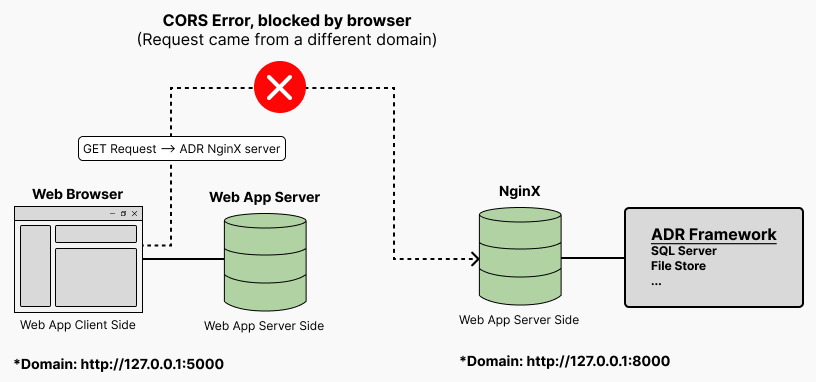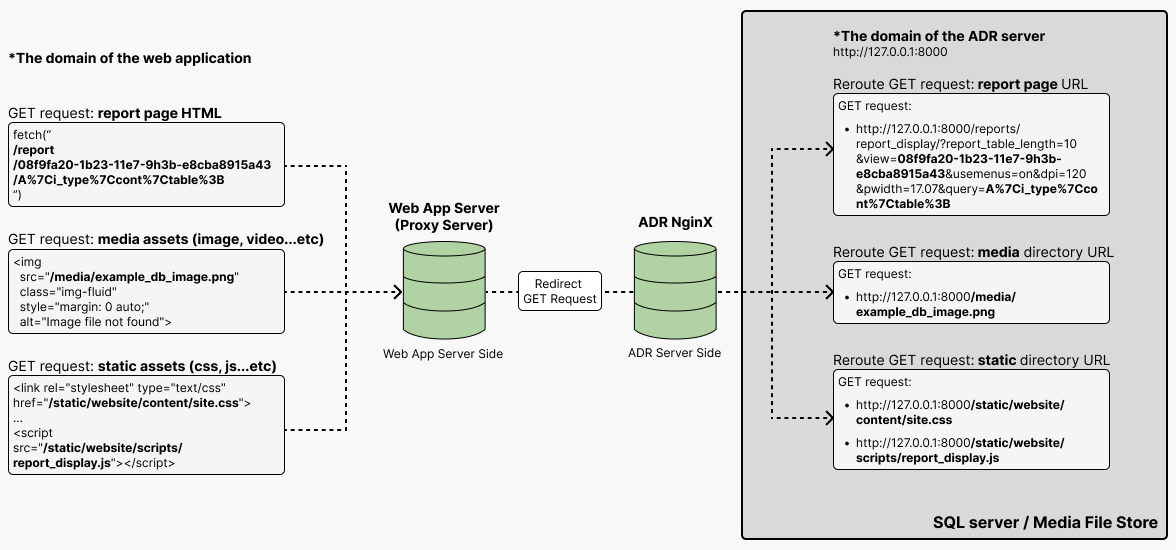Note
Go to the end to download the full example code.
Embed report and overwrite styles#
Applying the new custom web component <adr-report></adr-report> as an alternative of
using <iframe></iframe> to fetch and embed a report in the external web application.
Note
This example assumes that you have a local Ansys installation with a version v251 or beyond. For this feature, as of 25R1, Panel and Tabs are the only layout templates available for style overwrite, more templates will be included in the future release.
Start an Ansys Dynamic Reporting service#
Start an Ansys Dynamic Reporting service using an existing database that has at least 1 report template being defined.
Note
The code here to start an ADR service and the following Python code to initiate
a Flask server should all be put together in the app.py file. The
file structure of this example is demonstrated at the end of the tutorial.
from random import random as r
import numpy as np
import ansys.dynamicreporting.core as adr
from ansys.dynamicreporting.core.utils import report_utils
# Find a random open port for the ADR service & define the ADR root domain
adr_port = report_utils.find_unused_ports(1)[0]
root = f"http://127.0.0.1:{adr_port}/"
# start an ADR server
adr_service = adr.Service(
# (installation version should be >= v251)
ansys_installation=r"C:\Program Files\ANSYS Inc\v251",
# Unlike previous examples, the db_directory MUST have an existing database in it
db_directory=r"D:\tmp\new_db",
port=adr_port,
)
adr_service.start()
# Select report based upon the matched report name
my_report = adr_service.get_report(report_name="Top Level Report")
Set up proxy server#
Applying the custom web component to tunnel the report over to the external web app requires additional server settings to bypass potential cross-origin resource sharing (CORS) error. See below diagram illustrating the CORS error process:

By default, browsers will block requests from the client side towards the server side of a different domain#
To resolve the CORS error, instead of sending requests from the client side, using the server that powers the external web app to proxy the requests. Adding 3 types of REST calls reroute settings to set up the proxy server:
Reroute GET Request to the main ADR report page (for HTML content)
Reroute GET Request to access the ADR report’s static files
Reroute GET Request to access the ADR report’s media files
The below diagram illustrates the proxy server concept to bypass CORS error:

Bypass the CORS error by using the app server to proxy the request#
This example is using Flask as the backend framework, but the same concept is applicable to other backend structures such as Node.js.
Note
Using Flask as the backend framework to set up proxy will serve the static assets like CSS, JS files in its “static” directory, the GET request to ADR’s static assets may cause request conflicts (same for requesting “media” files).
Therefore, the below code example includes rewriting request for “static” files and “media” files to avoid such conflicts, please refer to the highlighted code block.
from flask import Flask, Response, redirect, request # noqa: F811, E402
from requests import get # noqa: F811, E402
# init Flask app
app = Flask(__name__)
# Flask serves its own static files from "/static/"" directory by default, to avoid conflicts occur while getting
# report's "static" files, intercept the GET request and rewrite the route from "/static/" to "/adr_static/"...
# if the given patterns match (*Do the route rewrite for media files too)
@app.before_request
def intercept_request():
# rewrite GET request path to ADR "static" files if the given pattern(s) match(es)
if (
request.path.startswith("/static/website/content")
or request.path.startswith("/static/website/scripts")
or request.path.startswith("/static/ansys")
):
static_path = request.path.replace("/static/", "/adr_static/", 1)
return redirect(static_path)
# rewrite GET request path to ADR "media" files if the given pattern(s) match(es)
if request.path.startswith("/media/"):
static_path = request.path.replace("/media/", "/adr_media/", 1)
return redirect(static_path)
# reroute GET request path with a pattern of "/report/..." to main report HTML page
@app.route("/report/<path:subpath>", methods=["GET"])
def proxy_core(subpath):
subpath = subpath.split("/")
# Construct the target URL for request reroute to get the report page HTML
target_url = f"{root}/reports/report_display/?report_table_length=10&view={subpath[0]}&usemenus=on&dpi=120&pwidth=12.80&query={subpath[1]}"
resp = get(target_url)
return Response(resp.content, content_type=resp.headers["Content-Type"])
# reroute GET request path with a pattern of "/adr_static/..." to access report "static" files
@app.route("/adr_static/<path:subpath>", methods=["GET"])
def proxy_static(subpath):
# Construct the target URL for request reroute to get the report static files
static_url = f"{root}/static/{subpath}"
resp = get(static_url)
return Response(resp.content, content_type=resp.headers["Content-Type"])
# reroute GET request path with a pattern of "/adr_media/..." to access report "media" files
@app.route("/adr_media/<path:subpath>", methods=["GET"])
def proxy_media(subpath):
# Construct the target URL for request reroute to get the report media files
media_url = f"{root}/media/{subpath}"
resp = get(media_url)
return Response(resp.content, content_type=resp.headers["Content-Type"])
HTML structure and report style overwrite#
The following code snippet is a basic HTML structure in the index.html
file to serve the web component, its script, and the style sheet for style
overwrite (if any). For reference, here is the file structure of this example:
example_root /
├── app.py (start an ADR service & initi Flask proxy server)
├── static / style.css
├── templates / index.html
Note
The CSS stylesheet to overwrite report styles should be added as a <link> tag
inside the <head></head> section of the HTML file. The href attribute
of the <link> tag displays the CSS file path, which should then be passed as
the value of the style_path argument in the
get_report_component(style_path="...")
in order to overwrite the styles.
<!DOCTYPE html>
<html lang="en">
<head>
<meta charset="UTF-8">
<meta name="viewport" content="width=device-width, initial-scale=1.0">
<title>Document</title>
<!-- external CSS file for style overwrite -->
<link rel="stylesheet" href="{{ url_for('static', filename='style.css') }}">
</head>
<body>
<!-- <adr-report> web component generated by PyADR API from the backend -->
<main id="dash-container">
{{ custom_html_element | safe }}
</main>
<!-- <adr-report> web component <script> define generated by PyADR API from the backend -->
<script type="text/javascript">
{{ inline_js | safe }}
</script>
</body>
</html>
Initiate web component to embed the report#
At this point, all the essential server settings have been included, now it’s time
to add the custom web component and its script in the external web app by PyADR
method get_report_component
and get_report_script.
As mentioned above, if a CSS file has been included for style overwrite, the file path
should be passed in the style_path argument of the get_report_component method.
from flask import render_template, url_for # noqa: F811, E402
# root domain
@app.route("/")
def index():
return render_template(
"index.html",
# inject the report fetch web component html
custom_html_element = my_report.get_report_component(
# Prefix of the proxy request to main report HTML content
prefix = "report",
# Optional argument for style overwrite (Using external CSS file)
style_path = url_for("static", filename = "style.css"),
),
# inject the report fetch web component script logic
inline_js = my_report.get_report_script(),
)
# Run the Flask server at port 5000
if __name__ == "__main__":
app.run(host = "127.0.0.1", port = 5000)
The below screenshot demonstrates the simple style overwrite result for report’s panel layouts.

A screenshot of report style overwrite for the Panel layouts#
Close the service#
Close the Ansys Dynamic Reporting service. The database with the items that
were created remains on disk. To stop the Flask server in this example,
a Keyboardinterrupt like (Ctrl + C) will shut down the server.
# sphinx_gallery_thumbnail_path = '_static/00_complete_report_0.png'
adr_service.stop()

